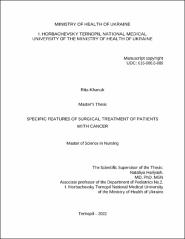| dc.description.abstract | Malignant tumors are the second leading cause of death worldwide, accounting for approximately 10 million deaths each year, or nearly one in every six deaths. The incidence of cancer increases sharply with age; in older people, malignancies are represented very widely, most likely due to the accumulation of risks for specific cancers that increase with age. The selection of treatment strategy for malignancies is performed on a collegiate basis, with involvement of surgical, chemotherapeutic and radiation modalities. The nursing personnel should guarantee an individualized approach to treatment of cancer patients. That's why the aim of the research was to conduct a study of specific features and modern options for surgical treatment of patients with cancers.
This study was a retrospective descriptive analysis of the medical cards of 510 patients diagnosed with cancer. For this purpose clinical examination and modern instrumental and laboratory methods of diagnostics were used. To compare the patients’ outcomes with different treatment modalities and postsurgical care methods of statistical comparative analysis was used.
With the study findings it was proved that the correct and timely surgical treatment of cancer requires early and accurate diagnosis. Biopsy with hystological testing holds the leading role in acurate cancer diagnostics, followed by radiologic imaging and radioisotope diagnostics.
Surgical interventions are the most efficient method at early stages of malignant processes and are frequently combined with chemotherapy and radiation therapy. Although radical surgeries were more frequent among studed patients (57.4 %), reconstructive, palliative, and diagnostic interventions were also applied.
To improve the outcomes psychological support for the family members should be provided with nurses leading the process. This implies “working” with fears, changing the attitude to the disease, and, most importantly, refocusing the family’s and the patient’s attention from the disease to the everyday chores and activities of the family unit. | uk |

